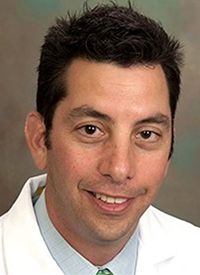Novel Approaches Emerge in AL Amyloidosis
Michael Rosenzweig, MD, discusses emerging treatment options for patients with immunoglobulin light chain amyloidosis such as daratumumab and NEOD001.
Michael Rosenzweig, MD

Michael Rosenzweig, MD
Much like multiple myeloma, the treatment landscape of immunoglobulin light chain (AL) amyloidosis is rapidly expanding with novel systemic therapies, says Michael Rosenzweig, MD.
Daratumumab (Darzalex) has been shown to induce deep and rapid hematologic responses in pretreated patients with AL amyloidosis. Results from a prospective phase II study showed that the hematologic complete response rate was 17% in 24 evaluable patients. Additionally, 29% of patients experienced a very good partial response, and 17% achieved a partial response. The overall response rate for daratumumab in this population was 63%.
Early data for the novel anti-amyloid fibril therapy, 11-1F4, also known as CAEL-101, have suggested preliminary signals of efficacy as well, said Rosenzweig.
In addition to daratumumab and other novel agents, Rosenzweig says that the well-known antibiotic doxycycline is showing promise in patients with amyloidosis. Doxycycline has been successful in stabilizing light chains and preventing further organ involvement in clinical trials of patients with amyloidosis.
OncLive: Can you provide an overview of your lecture on new agents in AL amyloidosis?
In addition to the anti—plasma cell modalities that are new for treating AL amyloidosis, one of the most exciting new approaches is the treatment for the amyloid deposition that occurs in the organs and tissues. Up until recently, there was nothing at all to help patients once the amyloid had deposited in [these areas]. All we had was to attack the plasma cell clone and, over time, the organs could heal. They don't always heal, and if they did, it would take a long time. Now, there are the new approaches of using monoclonal antibodies to target amyloid depositing in the organs, which is very exciting.
How do patients generally tolerate the current standard of care?
There is another drug that was presented at the 2017 ASH Annual Meeting, called 11-1F4, which is also showing promise as an anti-amyloid therapy. The last drug that I discussed is a very old drug called doxycycline, which as we know is an antibiotic. Preclinical studies have shown that it has been effective at stabilizing the light chains and preventing further organ involvement. Very well. The current standard of care, for those who are eligible, is autologous stem cell transplant. When not possible, we use a bortezomib (Velcade)-based regimen that is generally well tolerated. What is exciting is that daratumumab is very well tolerated, so that is making its way up into the frontline setting. We are doing a clinical trial there to explore daratumumab in combination with bortezomib-based regimens for AL amyloidosis. What we are learning about these monoclonal antibodies is that they are very well tolerated.
What is the clinical benefit of newer agents?
Are there enough data to start using doxycycline in practice?
Is there anything else to take note of in this landscape?
The organ involvement often makes these patients frailer than a typical patient with myeloma. Therefore, using these drugs with great caution is very important. The clinical benefit is organ improvement for heart, kidney, and neuropathic symptoms. What we don't know is whether those benefits are going to be better than just the time of occurrence following hematologic response and control of the plasma cell disease, or if the drug offers benefit over placebo. [11-1F4] is earlier in development. There was a phase I trial that did show some clinical benefit, but the phase II studies still need to be [conducted]. With doxycycline, yes. There are preclinical data, as well as some clinical studies that are very encouraging, and these are enough for us to start using it in clinical practice. What is nice about doxycycline is that the toxicity profile is so good that the benefits outweigh the risks. One area to emphasize is thinking about amyloidosis in the community. Patients do well with amyloidosis when it is diagnosed early and treatment is started early. We have exciting new treatments that can benefit patients by attacking the plasma cell clone early, but when organs get advanced involvement, patients are often not eligible for these therapies. The community [needs] to be aware of the disease, and being proactive about making the diagnosis is definitely an area to emphasize.
Reference
Roussel M, Stoppa AM, Perrot A, et al. A prospective phase II of daratumumab in previously-treated systemic light-chain (al) amyloidosis. In: Proceedings from the 59th ASH Annual Meeting and Exposition; December 9-12, 2017; Atlanta, Georgia. Abstract 508.
 
In an interview during the 2018 OncLive® State of the Science Summit™ on Multiple Myeloma and Myeloproliferative Neoplasms, Rosenzweig, assistant professor in the Department of Hematology and Hematopoietic Cell Transplantation, City of Hope, discussed these emerging treatment options for patients with AL amyloidosis.Rosenzweig: The standard approach to treatment today targets the underlying small plasma cell clone that is responsible for the light chains that are producing amyloid and then depositing it in organs and tissues. The goal of treatment is to attack that plasma cell clone and eliminate it. New drugs and exciting developments that have happened recently go hand in hand with the progress that has been made for multiple myeloma. Daratumumab is an exciting new drug for relapsed myeloma moving up to the frontline setting. Likewise, for AL amyloidosis, it has been studied and found to be very effective.



